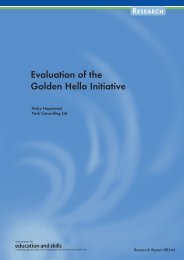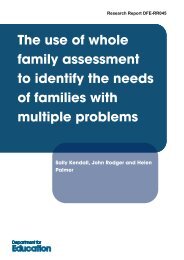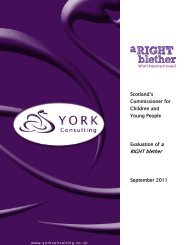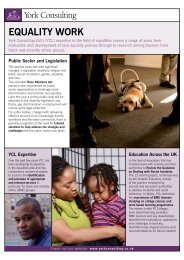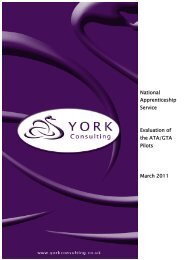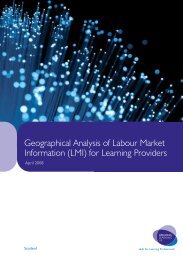Recruitment and Retention in the Post-16 Learning and Skills Sector
Recruitment and Retention in the Post-16 Learning and Skills Sector
Recruitment and Retention in the Post-16 Learning and Skills Sector
You also want an ePaper? Increase the reach of your titles
YUMPU automatically turns print PDFs into web optimized ePapers that Google loves.
Ma<strong>in</strong> Benefits <strong>and</strong> Drawbacks of Work<strong>in</strong>g <strong>in</strong> <strong>the</strong> <strong>Sector</strong>10.12 The key benefits identified by staff work<strong>in</strong>g <strong>in</strong> <strong>the</strong> post-<strong>16</strong> sector are;personal rewards ga<strong>in</strong>ed from teach<strong>in</strong>g, professional rewards fromwork<strong>in</strong>g with <strong>the</strong> client group, a sense of contribut<strong>in</strong>g to <strong>the</strong> community,<strong>the</strong> supportive work<strong>in</strong>g environment (less so for part-time <strong>and</strong> sessionalworkers), flexibility <strong>and</strong> autonomy.10.13 The ma<strong>in</strong> drawbacks of work<strong>in</strong>g <strong>in</strong> <strong>the</strong> sector relate to organisationalissues (<strong>and</strong> a lack of fund<strong>in</strong>g), low pay, <strong>in</strong>secure terms <strong>and</strong> conditions,paperwork <strong>and</strong> bureaucracy, constant change <strong>and</strong> unclear careerpathways.10.14 Pay is not <strong>the</strong> most important drawback as perceived by staff althoughit is raised regularly by those who are consider<strong>in</strong>g leav<strong>in</strong>g <strong>the</strong> sector.Those work<strong>in</strong>g on a part-time or sessional basis perceive some specificdrawbacks <strong>in</strong>clud<strong>in</strong>g less support from <strong>the</strong>ir employer, less access totra<strong>in</strong><strong>in</strong>g <strong>and</strong> development, <strong>and</strong> concerns about tenure of position.Reasons for Leav<strong>in</strong>g <strong>the</strong> <strong>Sector</strong> <strong>and</strong> Subsequent Dest<strong>in</strong>ations10.15 Most respondents <strong>in</strong>terviewed as part of this research expect to staywork<strong>in</strong>g <strong>in</strong> <strong>the</strong> post <strong>16</strong> sector <strong>and</strong> are committed to do<strong>in</strong>g so. Evidence<strong>in</strong>dicates that many ‘leavers’ stay with<strong>in</strong> <strong>the</strong> sector.10.<strong>16</strong> Key reasons for consider<strong>in</strong>g leav<strong>in</strong>g held by potential leavers <strong>in</strong>cludethose recent entrants whose expectations have not been met, thosewho never saw teach<strong>in</strong>g/tra<strong>in</strong><strong>in</strong>g as a long term career <strong>and</strong> those forwhom <strong>the</strong> drawbacks have started to outweigh <strong>the</strong> benefits.Areas for Fur<strong>the</strong>r Consideration10.17 The issue of pay rema<strong>in</strong>s important across <strong>the</strong> sector, particularly <strong>in</strong>fur<strong>the</strong>r education. It is not <strong>the</strong> most important drawback perceived bystaff however, <strong>the</strong>re is a sense of imbalance particularly compared witho<strong>the</strong>r education sectors such as schools. Some HR managers feel thatlower pay may be limit<strong>in</strong>g <strong>the</strong> quality of applicants, particularly <strong>in</strong> certa<strong>in</strong>subjects. However, many <strong>in</strong>dividuals cont<strong>in</strong>ue to enter <strong>the</strong> sector fromwork<strong>in</strong>g <strong>in</strong> schools <strong>and</strong> cite specific benefits which clearly override anyperception of low pay.87



